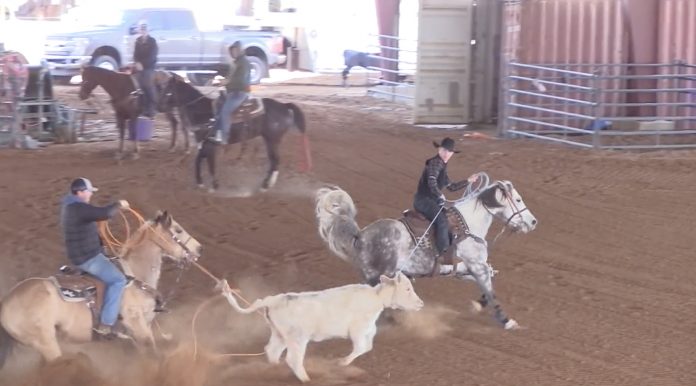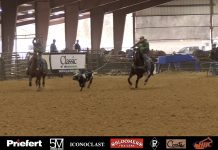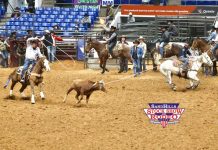Breaking it Down by Speed Williams – February 2024
I would like to start by congratulating Tyler Wade and Wesley Thorp for winning their world championships. I’ve visited with Wesley about heeling since he was just a kid. I’m happy for him and what he’s accomplished. The quality of talent at the NFR sure makes it enjoyable to watch. Just knowing that every team there can make 3-second runs makes it very exciting. The headers who can set up the run and make the heeling look easy really stand out. It’s not often during the year these ropers get to compete in the same set up as the Thomas & Mack. It takes many runs to be prepared for the Thomas & Mach because the math is so different than normal competition
Some of the headers I teach struggle at jackpots because they watch the NFR and want to emulate those guys. They try to rope both horns at the same time, or rope going to cattle, and it’s difficult on slow steers with bigger horns from longer boxes than the set up at the Thomas & Mack. Trying to be a fast 3 versus a solid 7 is a completely different run. This is one thing I work on with my heading students – understanding the difference between a jackpot and rodeo run.
One of the most common problems is headers getting in a hurry and not handling the steer in a controlled angle and speed. Heeling is an art where you’re reacting to what the header does. If the header does his job correctly, heeling is a lot easier.
I made the NFR heeling ini 1988 when I was 20. When Clay Cooper asked me to rope, I had made the NFR heading twice (in 94 and 96), and felt I’d been successful in the team roping world. One of the most special things I found when roping with Clay was, he would ride to the back on every steer and help me get my rope. That meant a lot to me, especially because we roped so many fresh steers. He didn’t always say much, so when he did, I sure listened.
The first time we practiced and ran a couple of steers, we’re riding back up the area when Clay asked me, “Where are you headed? When you rope where are you headed?” I told him I’d always been taught to go straight across the pen. He said, “Out here the score is a lot longer and the steer is running faster. When you rope the steer and turn him, as his butt lines up with his head, I need you to come back up the arena 10 to 15 degrees to open the steer up where his right front leg doesn’t affect my heel rope.”
From the age of 12, I’ve won a lot heeling. Probably every major roping in the east, the IPRA championship a couple of times and thought I knew a lot. But Clay was my hero growing up. When he told me this, and I visualized it in my mind, it made perfect sense. All I’m doing is clearing out the front legs for the heel rope. Now, as a teacher, I have called Clay 15 or 20 times in the last 10 or 15 years when I have a heeler who is adamant that his steer needs to go across the arena. I just hand them the phone and let them talk to Clay. When they hang up, they’re usually satisfied. So far, no one has wanted to argue once Clay explained it. I thought the same way until he explained it to me.
The art of handling steers is something I’ve really worked hard at in my career. No matter how far I reached, having control of my horse and being able to use my legs to do so, played a big part. Your horse needs to be able to side pass, flex, bend and respond when you pull on the reins or use your legs.
One of the drills I have clients do is weave through barrels using their legs while swinging their rope. This helps your horse learn to move off your legs. It’s amazing how many people I put on the Speed Trainer to teach them how to swing their rope and be able to use their legs while swinging their rope. It’s very difficult to use just one leg versus kicking with both legs. Learning to use your legs individually helps you to learn to control your horse better.
Typically, the first thing they do when they kick with the left leg is stop swinging their rope and pull on the reins for balance. That’s where the Speed Trainer is essential because you can learn to do all those things at once. I learned to use my hands and feet because my dad was a trader who bought and sold horses. We bought a lot of horses that were blown up. I learned how to use my feet because I was riding a lot of different horses all the time and had to learn to control them.
I truly enjoy teaching my kids and clients how to ride their horses correctly, and to understand that horses are way more intelligent than most people realize. It’s eye opening when you see yourself on video giving your horse the opposite instructions of your actual intentions and the horse still operates correctly, even with your feet and hands in the wrong position.
I have clients that will run up and rope a steer and when they pull their slack, their hand will go straight left. And even though they are riding horses that are dead broke with lots of buttons, their horse works correctly. They are reining their horse to go left, but the horse knows this is not what he wants and will wait until he gets a dally. It’s amazing to me that horses can and will do this.
I’m very blessed that so many people come to me for help with their roping and I’m able to teach and help people understand what goes wrong in a team roping run. It’s surprising how many heelers come for lessons and for an understanding of fundamentals. I think that’s due to Gabe’s heeling success. I think he heels outstanding. Gabe has been working on his heading and it’s my goal to teach him to head correctly. He turns 18 in October, and we’ll see if by then his heading has caught up to his heeling ability. I would like to see him have options when it comes to his roping career.
Hali is still struggling. Once her foot healed, we did an MRI on her knee and found she has some minor tears in her ACL. It’s hard to believe that one horse stumbling and falling on her foot has affected her so much. She’s not been able to practice or ride. When one thing heals, we find something else.
I’m very fortunate that both my kids love to rope and want to be in the arena with me because it’s the one thing I can teach them. If you’re interested in being videoed and seeing what you look like on our big screen in slow motion, reach out and we’ll what we can do to help you understand more about what’s happening in your run.




